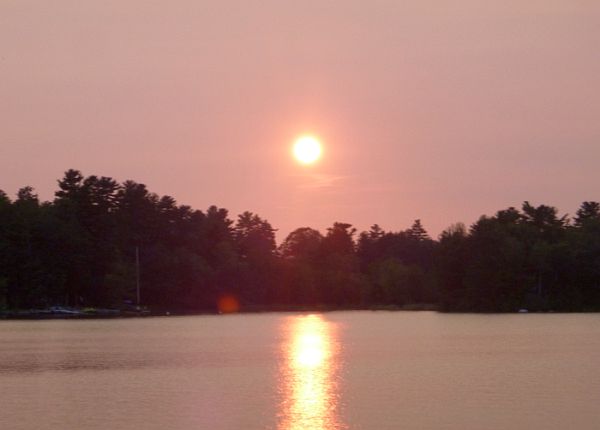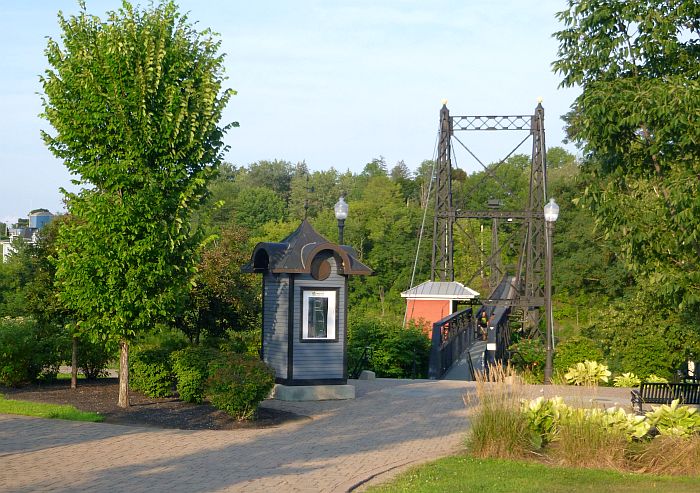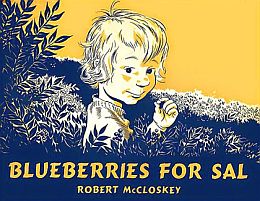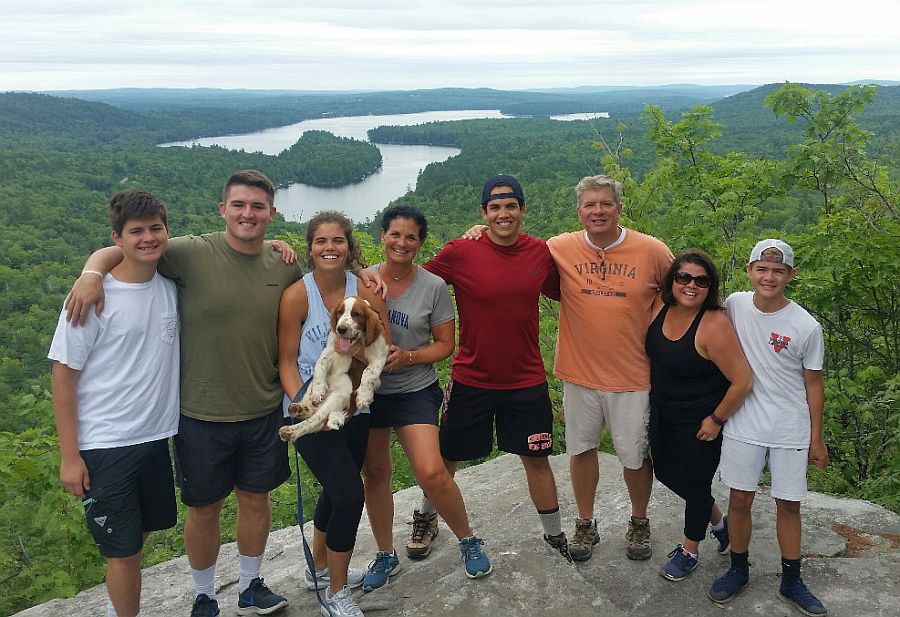
An artist's conception of part of the RiverWalk, now under construction at Head of Falls in Waterville. The former Scott Paper Mill appears background right. The completed walkway will be dedicated in early October. More…
Highlights from this issue…
- Fifty Nifty Ways To Exit Summer
- End of Season Letter
- Rebirth of the Riverfront: A New Park To Open in Waterville in October
- Snowbirds On the Loose
- Bluberries for Sal
- Hiking Again
Download Full Print Edition [PDF] • Links to Other Pages on This Site
These archival articles are presented “as is.” Except for minor corrections or clarifications, most have not been updated since they appeared in print. Thus, some details may be out of date, and some hyperlinks may no longer work.
Fifty Nifty Ways To Exit Summer
Lingering memories, muscles, souvenirs, a tan! There's no way that summer definitively ends, but leaving it for other climes and times and seasons and reasons is best transacted with the celebration of the great, late days of the season.
How to celebrate? Check these out, or off:
Eat ice cream outdoors • Donate food to a local cupboard • Climb a mountain • Climb The Mountain • Roller skate by a lake • Ice skate in a Vault • Picnic in a park • Visit a local cemetery • Visit a Quaker cemetery • Visit a Veterans Cemetery • Cross the Kennebec on a foot bridge • Cross a lake quietly: canoe, kayak, paddleboard, swim • Hug a child or grandchild • Hug a dog or cat or horse • Hug a tree • Shop for souvenirs • Shop for Christmas or other holidays • Eat pie a la cheddar cheese • Eat a whoopie pie • Send a cake-size whoopie home • Jump in a lake • Jump in a pool; join one for the winter • Listen to the loons • Learn a loon call • Collect colorful leaves • Take a rainy-day walk • Find faces and figures in clouds • Follow a rainbow • Brake for a family of birds • Read an old book from a camp shelf • Visit a library • Join a book group • Go to a book sale • Give books as gifts • Drive to a high hill • Go to a country fair • Catch an outdoor concert • Visit a farmers' market • Stop at a roadside stand • Eat local veggies • Sit for a sunset • Watch the wonderings of a child • People watch from a sidewalk cafe • Window shop along an historic main street • Take a walk in the woods • Follow a trail along a river • Pick the berries of the season • Pick-your-own apples • Collect camp memorabilia • Amble through an antique emporium • Stroll through a greenhouse or arboretum • Plant a tree • Pull weeds • Thank a volunteer, or become one • Eat a red hot dog • Visit an historic site • Try to catch a white cap • Become a member of an association • Plan for next summer
There are fifty, nifty — What, only fifty? — ways to enter summer…
Print Article • Go to Top of Page
End of Season Letter

Dear Readers,
As summer businesses shut down and students head on to school, as loons will soon raft and the foliage of fall will light up the hills, Summertime in the Belgrades as always thanks everyone who is so supportive of its pages:
- To our advertisers, who remain so positive and make the newspaper possible.
- To our contributors, especially Pete Kallin, Martha Barkley, Rod Johnson and Dale Finseth, who share their special interests in our pages.
- To our small but diligent staff, especially Michael Breault and Gregor Smith, who mastermind the logistics and electronics, and accomplish a good share of the distribution.
- And to our family, especially 3rd generation Ethan and Corey, who have survived many summers of deadlines and distribution.
Of course, we thank our readers. You are amazing because we see you reading Summertime everywhere and anywhere throughout central Maine, because you reach for a copy before it is even on the shelf, and because you continually compliment us about the paper's contents.
The summer of 2018 was hot, it was humid, it went by too fast, it was a lot of work for seasonal businesses and workers, but it was no less special for vacationers, visitors, and residents who equally enjoy the sparkle of open water around almost every bend on any route taken, who revel in the freedom of long days and lightweight clothes, and who know that fun outings and events abound whether it is possible to do them all or to just select the one or two that highlight the summer.
May you move on to a great fall and a good winter. And then? It's summer again.
Esther, Corey, Ethan Michael, and Gregor
Print Article • Go to Top of Page
Rebirth of the Riverfront: A New Park To Open in Waterville in October

An artist's rendering of the southern end of the walkway shows the Two Cent Bridge and the gazebo.
On October 6, the City of Waterville will dedicate a new walkway and park at Head of Falls, a once-thriving residential and industrial neighborhood that is now a largely vacant strip of land adjacent to downtown Waterville along the Kennebec River. The $1.5 million project will be the property's most visible enhancement since it was cleared of buildings during Urban Renewal more than four decades ago.
The centerpiece of the new park will be a wide, curving, handicapped-accessible walkway along the river bank, starting at the Two Cent Bridge and proceeding northward to connect with existing trails. Dubbed "RiverWalk at Head of Falls," the hard-surfaced, 2200-foot-long walkway will have a gazebo at its southern end, by the bridge, and an outdoor amphitheater at the northern terminus, with tiered seating for 150 facing the river. Along the walkway will be play areas for children, ornamental shrubs, and informational kiosks and art installations about the river and Waterville's rich and varied past.
As part of the project, the rotating, metal sculpture "Ticonic" was moved in early May from a traffic island in the Concourse to a spot just south of the amphitheater. Named after the falls themselves, the 33-foot-high sculpture by the late Roger Majorowicz was originally installed in November 1997.
Head of Falls has been in use for centuries, first by Native Americans, who established a burial ground stretching from present-day Temple Street to the Hathaway complex, and later by European settlers, who used the falls as a source of power for industry. The Lockwood Cotton Mill opened in 1875 — the mill complex is now called Hathaway, since the Hathaway Shirt Factory moved into Mill #2 after Lockwood closed in 1956 — followed by the Waterville Iron Works and the Wyandotte Worsted Woolen Mill, and the Hollingsworth & Whitney (later Scott) Paper Mill just across the river.
In 1901, a footbridge was built to make it easier for residents of Head of Falls to get to jobs at the paper mill. The bridge was washed away in 1902, but was replaced with the current suspension bridge in 1903. Constructed by the Ticonic Foot Bridge Company, it was dubbed the "Two Cent Bridge," as one had to pay two cents to cross. Although the bridge is now public property and tolls have not been collected for decades, the name lingers and the structure is the oldest surviving toll footbridge and, at 576 feet, the longest pedestrian suspension bridge in the United States.
According to local historian and author Earl Smith, whose 2016 novel Head of Falls was set in that neighborhood in the 1950s, "At the peak (1940-60), there may have been as many as 100 families, mostly Lebanese, a few French, living in mostly tenement, a few single family homes. Otherwise, the neighborhood had the Wyandotte Woolen Mill (on the riverbank, immediately north of the Two Cent Bridge), the Iron Works, farthest north at [Head of Falls], and a number of warehouses along the railroad tracks, used by both Wyandotte and the Lockwood Cotton Mills, below, near the bridge."
By the start of the Head of Falls Urban Renewal Project in 1972, the area had become run down and fewer than 20 families were left. The Waterville Iron Works had closed two years earlier, after more than a decade of hard times. The remaining families were moved out and the Wyandotte Mill relocated to southern Waterville countryside at the corner of West River Road and Trafton Road.
During the next three decades, due to a mixture of indifference and disagreement among the city's leaders and residents over what to do with the property, the land sat vacant. Cleared of all buildings, only the footbridge remained, a testament to happier and more prosperous times.

Two Cent Plaza, at the Waterville (western) approach to the bridge.
The area was not entirely neglected. A field just north of the bridge was occasionally used for concerts and festivals, and more infamously, as a dumping ground for snow collected from downtown streets. Also, about three decades ago, the city built a paved and lighted, 70-space parking lot south of the bridge to provide all-day parking for employees of downtown businesses and overflow parking for patrons at Opera House events in the evening.
In 2000, the city commissioned a master plan for the redevelopment of Head of Falls. The plan envisioned an amphitheater, an entry plaza at the western end of the Two Cent Bridge, a one-acre park for "both leisure activities and community gatherings," a "riverfront promenade" to connect the bridge to a skating rink, playground, and sports field at the northern end of the property.
The plan also proposed a trail extending southward along the river from the Two Cent Bridge to Bridge Street, a parking area stretched out along the railroad tracks where they parallel Front Street, and, in the field between that parking area and the promenade, three mixed-use buildings housing retail stores, offices, and a restaurant and inn. In 2005 and 2006, using a $500,000 grant from the state and $1.25 million in borrowed funds, the city built the parking area and installed underground water, sewer, and electrical lines to facilitate commercial development of the field.
In 2010, the city constructed an entry plaza at the western approach to the Two Cent Bridge. This included a walkway of pavers, benches, plantings, and an informational kiosk. The following year, extensive repairs to the bridge were completed. These included replacing cables and handrails, as well as the iron grates on both ends of the bridge. The Waterville approach to the bridge was also raised three feet to make it accessible to the handicapped.
The impetus for the RiverWalk came in August 2015, when the Waterville Rotary Club announced a $150,000 grant for the project in honor of the club's centennial. Other large grants and donations followed, including $300,000 from the Land and Water Conservation Fund, $150,000 from Kennebec Savings Bank, $100,000 from the Mitchell Family (that is, U.S. Sen. George Mitchell, his sister Barbara Atkins, their late brother John "Swisher" Mitchell, and other family members), $100,000 from the Elmina B. Sewall Foundation, $75,000 from Colby College, $50,000 from the Waterville Development Corp., $18,500 from the now defunct Waterville Main Street, $15,000 from Kennebec Messalonskee Trails, and $10,000 each from Inland Hospital and the Hathaway Business Group.
Construction of the new park is proceeding rapidly, and a dedication ceremony will be held on Saturday, October 6. Former U.S. Sen. George Mitchell, who grew up in Head of Falls, will speak.

In this overhead conceptualization of the northern end of the RiverWalk, the relocated Ticonic sculpture is the upper right and a pre-existing roadway and parking area runs along the top of the picture.
Print Article • Go to Top of Page
Snowbirds On the Loose
Are we talking about actual flying birds that stay in snow country all year long — or those that leave for warmer climates during the winter months? Actually neither, we are speaking of the exodus of humans, usually retired older folks, that leave their beloved abodes in north country and head for somewhere warm. Yup, that's who we are speaking of all right. Being one of them, I have been silently studying this phenomenon that has been going on in my family and thousands of others for many decades. Let's examine their modus operandi and see what subcategories might be developed.
A large portion of the snowbirds we know, fall into the "6 and 6" category. This means you leave the north more or less after foliage toward the end of October, stay in warm climates (usually Florida or Arizona, but not always) for six months, leave and come back to north around the early part of May. Some of these folks purposely stay in Florida for six months and a day to satisfy the IRS tax rules concerning state citizenship, no income tax, etc. Others feel the weather is generally conducive at those times — so they never see or deal with ice and snow. It's often seen as the best of both worlds while minimizing the negatives in both places (a rather large mouthful).
Having said all the above, let's face it, there are many variations. I would guess a second major category includes those who want to spend the holidays in the north, then head south. These folks are known in the snowbird vocabulary as snowflakes. These are quite a large segment that have children and grandchildren that they want to spend either Thanksgiving or Christmas with, sometimes both. These folks fall into a couple of subcategories, those who stay in the north until the first of January and thereby spend four months in the south, or those who go south in early November, fly home for the holidays, then return. Of course there are many variations of snowflakes as well.
I must comment on the short timers, a group who have one foot in retirement and one still working. These folks are not able to completely cut loose from the north for any great amount of time, but come and go back and forth as their schedule and budget allows. It is only fair that we mention the naysayers as well. These are the folks who not only love the cold and snow, perhaps winter in general, and would never consider spending any more time in the warm states than it takes to go to Disney with the grandkids. Each to their own, and maybe they deserve a name too, like ice cubes!
We might think that snowbirding is a new idea since the advent of automobiles and roads. After pondering the issue, one realizes that people as far back as Cro-Magnon man did annual migrations. Theirs was a more mandatory wandering to get where plants could survive and they could forage for food. The concept that warmer areas were easier to survive in than cold was not lost on them — nor is it lost on millions of North Americans who flood into warmer climates and return north in the spring. After all, who would want to miss the buds sprouting and the real birds returning to enjoy the cooler, more comfortable temperatures right here in good old New England.
May the continuous comings and goings continue and may many of you who would like to give this lifestyle a try, be able to do so in your future. Cheers from TLB.
Print Article • Go to Top of Page
Bluberries for Sal

August is blueberry picking time in Maine. I shopped for this children's favorite by Robert McClosky at both Maine Made in the Village and Day's Store: sold out, of course! So back to the public library I go once again…
You open this very delicious blueberry tale to a view of the wide, double page kitchen scene with August calendar on the wall. Sal is standing on a kitchen chair with a wooden spoon, spooling the rubber sealers for canning blueberries. Her mom is pouring blueberries into a canning glass Mason jar. How fun to look around their homey country kitchen, illustrated in deep blue ink by Robert McClosky: an old, wood-burning stove, open drawers, open sugar sacks, an open window to view hillside of pines, open and happy kitchen activity…mother and child concentrating on blueberry business, preserving for winter eating.
Plink, plank, plunk were the sounds I had in my mind for each blueberry Sal picked and threw into her tin pail. When I found the library book, it said "kuplink, kuplank, kuplunk"! The little bear ends up following Sal's mother while she is busily picking. Sal ends up following mama bear while crawling the hillside for blueberries. It is a different kind of coastal Blueberry Hill from our Belgrade Blueberry Hill: look at the McClosky blue ink drawing and find the differences in nature.
All ends safely in Blueberries for Sal with the bears, thank goodness. Robert McClosky has so many Maine tales with his detailed pen and ink art work: One Morning in Maine, Time of Wonder, Make Way for Ducklings, etc. (Sometimes in Belgrade Lakes Village, traffic stops to let a mother duck parade across busy street with her ducklings, but McClosky's story is in busy Boston with a cop blowing his whistle.)
"KA-THUD, KA-THUD, KA-SPLASH!" were the moose sounds as Maynard the moose arrives at the lake in Marybeth Baker's The Adventures of Maynard. All three of her Maine moose stories are signed by her and in our Belgrade library.
"Maynard was a kind-hearted moose. Deep in the forest of Maine's Mt. Katahdin he had many friends…Along the cat-tailed shore of Rainbow Lake, Maynard found a new and very special friend, Lala Loon."
Many moose titles and many loon picture books to select from for August reading and getting ready for school time. The Legend of the Loon by Kathy-Jo Wargin is a favorite, because illustrator Gijsbert van Frankenhuyzen really paints lush, richly colored scenes on every page. Both reader and non-reader will be mesmerized. We find Minnesota lakes are wondrous like our Maine lakes.
Lydia Johnson's 85th birthday was recognized in 2003 by a gift of Little Loon and Papa by Toni Buzzeo, illustrated by Margaret Spengler. William and Joan Alfond gave many children's books: This Moose Belongs to Me by Oliver Jeffers fits into our theme of moose. Thanks to both Brian and Jerod for collecting these fine books about Maine moose and loons…Janet reminded me that McClosky wrote Blueberries for Sal.
I wandered into our son's bunk room and found Homer Price by McClosky, a good read for middle schoolers. Jerod or Brian at the library called out to me when he found a loon AND moose book entitled Maynard and the Loon by M. Baker! We readers do get excited about finds on the shelf. "LA-LA-LOO-OOO-OOON!" from the book sounds like excited readers at the library finding books that are sold out in the village. Yippee!
P.S.
One summer we watched in our cove on Great Pond a mamma and papa loon diving and feeding their young chick ALL summer long. It was exhausting to watch their diving and returning every time we sat down to a meal of our own and observed…constant care by the loon parents is certainly a lesson for humans, isn't it?
Ospreys and their tremendous care of their young is very similar. We boat to Oak Island to check on the huge two floor condo that has built up through the years with returning ospreys. As we chug by slowly the warning cries and dipping and diving near us warns that we are too close to their young. Little beaks are open for food and parents are constantly feeding like the caring loons. Often I can hear the osprey clear across Great Pond at our camp by Runoia shores.
Moose have actually swum by our shores and "galumphed" up the rocks to Runoia's tennis courts where one was trapped for awhile. Yes, we even saw a moose cross Chandler Road one evening. Early one morning I am having my first cup of coffee on our porch when I notice the rock islands by Oak moving…it was a moose swimming from there across to Foster Point. We watched for an hour of slow motion swimming. Then we hopped into our camp boat and zoomed off towards Foster Point. There we found a worker painting and he told us they see moose all the time! Oh, we were excited at such a siting…
Jack McHugh's last summer at the lake in 2017 was very exciting for him and his large, extended family. They had a moose munching away for days along their camp road, McHugh Lane off Point Road. When the moose finally wandered away, Tom McHugh, Jack's son, ran into him on Woodland Camps Road. Have you had a moose encounter?
Print Article • Go to Top of Page
Hiking Again

The Mohr family on French Mountain.
Suddenly the days are getting a little shorter, and I am noticing swamp maples beginning to turn red in the wetlands and birches turning yellow high on the hillsides. It is still quite warm during the day, but the nights are growing cooler. Soon it will become easier to find a parking place in the village, at least until they start working on Main Street again after Labor Day. Like the birds and squirrels, I am double checking my summer "to do" list and trying to make sure everything gets done. I am amazed at how many things are still on the list. In addition to looking for mushrooms and elderberries when I hike, I find myself keeping my eyes peeled for grouse, deer, and turkey sign. Those seasons are rapidly approaching and last year's venison supply is running low in the freezer.

Addie Michaud and her kids with friends from Edmonton, Alberta.
One day last week, my wife and I packed a picnic lunch and climbed French Mountain just before noon. It was a beautiful sunny, but relatively cool day and we were not the only ones on the trail. When we got to the summit, two women were in a deep conversation looking out over the lake. We sat down to eat our lunch on the rocks above them and were soon joined by eight people hiking with a dog. At least one of the people and the dog looked familiar. It turns out that it was more of the Mohr family from Rockwood Shores that I had photographed on The Mountain a couple weeks earlier. Back then there were six people plus the dog. This time it was eight people plus the dog, with only one person that was in the last photo! The dog made both pictures. They said their extended family rotates in all summer and they all like to hike.
The Mohrs resumed their hike and my wife and I went back to our lunch. Suddenly we heard more voices coming up the trail. It was Addie Michaud from Mount Vernon, hiking with her kids and some friends from Edmonton, Alberta. Addie is the sister of my friend Lidie Robbins, who is the executive director of the 30-Mile River Watershed Association. The 30-Mile River Watershed includes over 20 interconnected lakes, rivers, streams, and and ponds that drain from Kimball Pond in New Sharon through Androscoggin Lake and the Dead River to the Androscoggin River, a distance of about 30 miles through portions of eight or nine towns in three different counties.

Enjoy the rest of your summer!
My wife and I then finished our lunch, hiked down the trail, and found enough black trumpet mushrooms along the way to make several tasty meals with these delicious morsels, including the venison-mushroom meatloaf that is cooking as I write this column.
It is hard to believe that this is the final issue of Summertime in the Belgrades for this year. I hope this column has inspired some of you to get out and explore the outdoor recreation opportunities the region has to offer and I hope you took a kid or two along. Until next year, I encourage everyone to "take it outside." For those of you who will be around for the winter, I encourage you to join me on the local trails on snowshoes or skis. Carpe ski-em!
Print This Article • Print All Articles • Go Back to Top

Download the Print Edition
The print edition includes all the above articles and much more. You can find a complete table of contents on p. 3. Adobe Reader is required.
◀— Previous • All 2018 Issues • Archives • Business Directory • About Us • Home • Next —▶
©2018 by Summertime in the Belgrades. All rights reserved.
